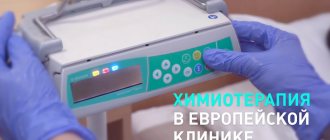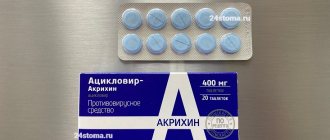Infliximab, 100 mg, lyophilisate for solution for infusion, 1 pc.
TNFα inhibitor. Infliximab is a chimeric mouse-human monoclonal antibody. It has a high affinity for TNFα, which is a cytokine with a wide range of biological effects, is also a mediator of the inflammatory response and is involved in the processes of modulation of the immune system. It is clear that TNFα plays a role in the development of autoimmune and inflammatory diseases. Infliximab quickly binds and forms a stable compound with both forms (soluble and transmembrane) of human TNF-α, and a decrease in the functional activity of TNF-α occurs. The specificity of infliximab for TNFα is confirmed by its inability to neutralize the cytotoxic effect of lymphotoxin alpha (LTα or TNFβ), a cytokine that interacts with the same receptors as TNFα.
Elevated concentrations of TNFα were detected in the joints of patients with rheumatoid arthritis and correlated with disease activity. In patients with rheumatoid arthritis, infliximab treatment resulted in decreased infiltration of inflammatory cells into inflamed joints, as well as decreased expression of molecules mediating cell adhesion, chemoattraction, and tissue destruction. After infliximab therapy, there was a decrease in serum concentrations of interleukin-6 (IL-6) and C-reactive protein (CRP), as well as an increase in hemoglobin concentration in patients with rheumatoid arthritis with a lower hemoglobin concentration compared to baseline levels. There was no significant decrease in the number of lymphocytes in the peripheral blood or their proliferative response to mitogenic stimulation compared with the response of cells from untreated patients in vitro.
In patients with psoriasis, infliximab therapy led to a decrease in inflammation in the epidermal layer and normalization of keratinocyte differentiation in psoriatic plaques. In patients with psoriatic arthritis, short-term therapy with infliximab was accompanied by a decrease in the number of T cells and blood vessels in the synovium and areas of skin affected by the psoriatic process.
Histological examination of colon biopsies taken before and 4 weeks after infliximab administration revealed a significant decrease in the concentration of TNFα. Treatment with infliximab in patients with Crohn's disease was accompanied by a significant decrease in the concentration of a nonspecific serum marker of inflammation, CRP. The total number of peripheral blood leukocytes changed minimally during infliximab therapy, although a trend towards normalization of their numbers was observed for lymphocytes, monocytes and neutrophils. In patients treated with infliximab, the proliferative response of peripheral blood mononuclear cells to stimulation was not reduced compared with that in untreated patients. There were no significant changes in cytokine secretion by stimulated peripheral blood mononuclear cells after infliximab therapy. A study of mononuclear cells from biopsies of the lamina propria of the intestinal mucosa showed that infliximab therapy causes a decrease in the number of cells expressing TNF-α and interferon gamma. Additional histological studies confirmed that infliximab reduced inflammatory cell infiltration and inflammatory markers in affected areas of the intestine. Endoscopic studies have demonstrated healing of the intestinal mucosa in patients treated with infliximab.
Not everything is so simple: possible problems when using monoclonal antibodies
Monoclonal antibody preparations have been used in rheumatological practice for quite some time. However, they are not prescribed to everyone - not to every first or even every second patient. The main limitation that doctors and patients face is the truly “exorbitant” cost of drugs in this group. Rheumatic diseases cannot be cured in a week or a month - they require many years (or even lifelong) use of therapy. Therefore, when selecting a drug, not only its effectiveness is important, but also its price.
For example, one pack of methotrexate costs approximately 200 rubles. The price of a package of infliximab is about 43 thousand rubles. The difference is obvious. For a year of treatment with methotrexate, even at the maximum dosage, the patient will spend 1–2 thousand rubles on the medicine (depending on the manufacturer, treatment regimen and the cost of the drug in local pharmacies). The price of annual therapy with infliximab is approximately 700 thousand rubles. It is clear that only a very limited group of patients will be able to provide themselves with this medicine.
Therefore, treatment of rheumatic diseases is carried out according to strict algorithms. If a pathology is detected, the patient is prescribed a basic drug. For example, for rheumatoid arthritis, methotrexate will most likely be the main drug. Doctors will add monoclonal antibodies to the standard treatment regimen only in exceptional cases. In Russia, they are considered reserve drugs—additional drugs that should be “left for later,” even despite their high effectiveness. So, if the severity of symptoms does not decrease for a long time (at least 6 months!), a biological drug can be added to methotrexate. Basic therapy is not canceled.
If the disease is initially highly active, progresses rapidly and is accompanied by extra-articular complications, then the patient can immediately be prescribed a combination treatment with basic drugs and monoclonal antibodies. This is due to the fact that biological drugs work best in the “acute period”, when the severity of symptoms is maximum. In addition, the effect of their use is observed faster. Treatment with infliximab produces results within 2–4 weeks, while methotrexate “starts working” only after several months.
The use of biological drugs is permissible in cases where the patient develops intolerance to basic drugs. Patients experience severe side effects from the medication, which further worsens their condition. The use of drugs with a different mechanism of action, including monoclonal antibodies, allows minimizing side effects [18].
The prescription and sale of biological drugs is controlled by the state. Many drugs from the group of monoclonal antibodies (infliximab, etanercept, tocilizumab, golimumab) are included in the “List of Vital and Essential Medicines”. In accordance with it, a list of medications is formed that are supplied to hospitals throughout Russia. Of course, biological drugs are not available in every hospital today. They are usually used in regional centers or specialized hospitals.
If they are unable to provide themselves with medications, patients receive disability and undergo therapy at state expense. This right is enshrined in the current “Program of State Guarantees for the Provision of Free Medical Care.” Treatment with biological drugs is provided for rheumatoid arthritis, ankylosing spondylitis, SLE, dermatopolymyositis, juvenile arthritis and other diseases. At the same time, doctors must determine clear indications for prescribing this or that drug. Getting expensive treatment is quite difficult - you need to undergo a full examination and collect documents. However, the provision of a state quota for many patients is the last chance for a full life.
Another difficulty that can be encountered when using biological drugs is adverse reactions. In parallel with the accumulation of data on the effectiveness of the use of drugs, new undesirable effects from their use are being identified. Most of these reactions are associated with the process of immunosuppression. By suppressing the activity of immune cells, monoclonal antibodies reduce the body's protective function. Anti-infective and anti-tumor immunity are primarily affected [18], [24].
Paradoxically, the use of new drugs against autoimmunity can cause acute autoimmune reactions. All biological drugs are protein molecules that are foreign to the body to one degree or another. Therefore, when therapeutic agents penetrate the patient’s body, the immune system can recognize them as antigens. An active immune response appears - antibodies are produced against the components of the drug.
Autoimmune syndromes provoked by drug administration are usually represented by vasculitis, SLE, antiphospholipid syndrome, and psoriasis [25]. Infliximab, which contains foreign murine fragments, is highly immunogenic. Fully “human” drugs provoke immunity less actively. But even with their use, there is a high risk of developing adverse autoimmune reactions. To eliminate these disorders, it is necessary to adjust the patient’s treatment regimen. It includes additional immunosuppressants that will suppress complications. This may be why combinations of biological drugs with disease-modifying drugs are often more effective than isolated therapy, even with the newest drugs [24].
Despite all possible difficulties, monoclonal antibodies have firmly entered the register of drugs used in rheumatology. The future of biologics and their place in rheumatology will depend on the results of many years of research that remain to be done. But even now we can say that the development of therapeutic monoclonal antibodies is an important step towards defeating autoimmune inflammation.
Literature
- Immunity: fight against strangers and... one's own;
- Systemic lupus erythematosus: a disease with a thousand faces;
- Rheumatoid arthritis: change the composition of the joints;
- Nasonov E.L., Alexandrova E.N., Novikov A.A. (2015). Autoimmune rheumatic diseases - problems of immunopathology and personalized therapy. Bulletin of the Russian Academy of Medical Sciences. 2, 169–182;
- Babaeva A.R., Kalinina E.V., Zvonorenko M.S. (2016). New opportunities to improve the effectiveness and safety of treatment of rheumatoid arthritis. Medical alphabet. 22, 5–12;
- Josef S Smolen, Robert Landewé, Ferdinand C Breedveld, Maya Buch, Gerd Burmester, et. al.. (2014). EULAR recommendations for the management of rheumatoid arthritis with synthetic and biological disease-modifying antirheumatic drugs: 2013 update. Ann Rheum Dis
.
73 , 492-509; - Nasonov E.L. (2015). Methotrexate for rheumatoid arthritis - 2015: new facts and ideas. Scientific and practical rheumatology. 4, 421–433;
- Kanevskaya M.Z. and Gurskaya S.V. (2013). Methotrexate in the treatment of rheumatic diseases. Modern rheumatology. 4, 47–53;
- D. T. Felson, J. S. Smolen, G. Wells, B. Zhang, L. H. D. van Tuyl, et. al.. (2011). American College of Rheumatology/European League Against Rheumatism Provisional Definition of Remission in Rheumatoid Arthritis for Clinical Trials. Annals of the Rheumatic Diseases
.
70 , 404-413; - Patrick Durez, Jacques Malghem, Adrien Nzeusseu Toukap, Geneviève Depresseux, Bernard R. Lauwerys, et. al.. (2007). Treatment of early rheumatoid arthritis: A randomized magnetic resonance imaging study comparing the effects of methotrexate alone, methotrexate in combination with infliximab, and methotrexate in combination with intravenous pulse methylprednisolone. Arthritis Rheum
.
56 , 3919-3927; - Monoclonal antibodies;
- 12 methods in pictures: immunological technologies;
- Autophagy, protophagy and others;
- Nobel Prize in Medicine or Physiology 2016: for self-criticism;
- Zaichik A.M., Poletaev A.B., Churilov L.P. (2013). Recognition of “One’s own” and interaction with “One’s own” as the main form of activity of the adaptive immune system. Bulletin of St. Petersburg State University. Episode 11. Medicine. 1;
- Autoimmunity. Modern views on the physiological and pathological aspects of autoimmunity. NSU Electronic Archive;
- For the first time in half a century, there is a new drug for lupus;
- Nasonov E.L. and Karateev D.E. (2013). The use of genetically engineered biological drugs for the treatment of rheumatoid arthritis: general characteristics (lecture). Scientific and practical rheumatology. 2, 163–169;
- Logvinenko S.I., Shcherban E.A., Pridachina L.S., Pridachina A.N., Maslova Yu.Yu., Kashichkina A.A. (2016). Genetic engineering in the treatment of ankylosing spondylitis (Bechterew's disease). Scientific bulletins of BelSU. Series: Medicine. Pharmacy. 19, 179–182;
- Masahiko Mihara, Misato Hashizume, Hiroto Yoshida, Miho Suzuki, Masashi Shiina. (2012). IL-6/IL-6 receptor system and its role in physiological and pathological conditions. Clin.
Sci. .
122 , 143-159; - Nasonov E.L., Alexandrova E.N., Avdeeva A.S., Panasyuk E.Yu. (2013). Inhibition of interleukin 6 - new possibilities for pharmacotherapy of immunoinflammatory rheumatic diseases. Scientific and practical rheumatology. 4, 416–427;
- Suponitskaya E.V., Alexandrova E.N., Aleksankin A.P., Nasonov E.L. (2015). The effect of therapy with genetically engineered biological drugs on B-lymphocyte subpopulations in rheumatic diseases: new data. Scientific and practical rheumatology. 1, 78–83;
- Babaeva A.R., Cherevkova E.V., Galchenko O.E., Solodenkova K.S. (2012). Biological agents in the basic therapy of rheumatoid arthritis. Medicinal Bulletin. 7, 3–9;
- Muravyov Yu.V. and Muravyova L.A. (2016). Untimely thoughts on the use of genetically engineered biological drugs for rheumatic diseases. Scientific and practical rheumatology. 3, 361–366;
- Psoriasis: at war with your own skin.


